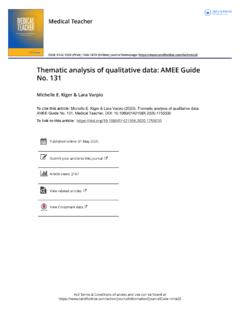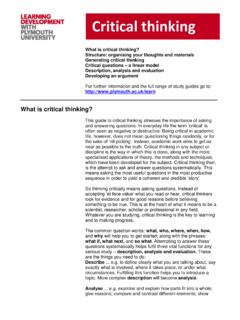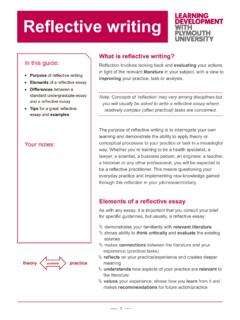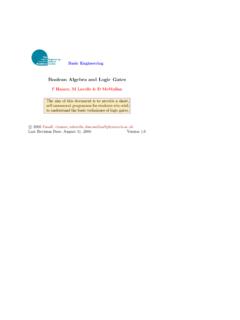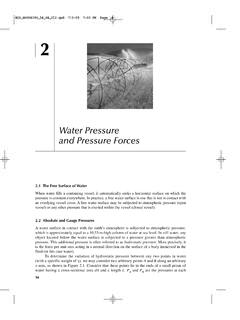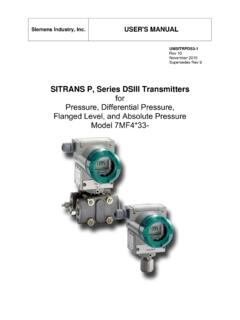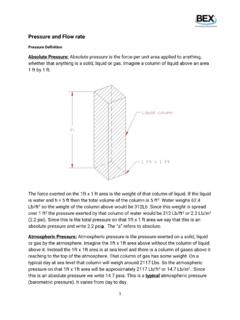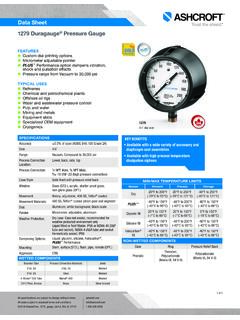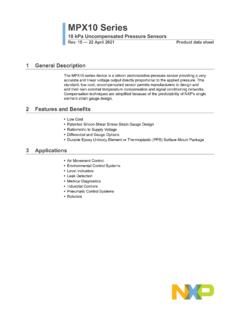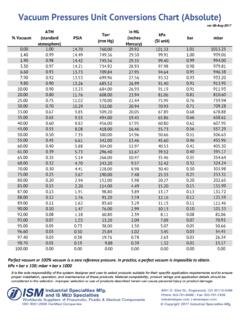Transcription of Pressure - University of Plymouth
1 BasicPhysicsPressureRHoran & M LavelleThe aim of this package is to provide a short selfassessment programme for students who want tounderstand Pressure and some of its , Revision Date: November 29, 2005 Version of (Density) QuizSolutions to ExercisesSolutions to QuizzesThe full range of these packages and some instructions,should they be required, can be obtained from our webpageMathematics Support 1: Introduction (Density)31. Introduction (Density)Density(symbol ) is defined by =massvolume= 1A cubic metre of gold has amassofm 2 the density of gold is given by mass over volume: gold=mV=2 104kg1 m3= 2 104kg m 2 Thedensity of wateris1 g cm 3, , a cubic centimetreof water has a mass of one gram. This can be expressed units(see the packages onUnitsand onChanging Units) as gram is10 3kgand one centimetre is10 2m.
2 Therefore1 cm3=(10 2)3= 10 6m3. This implies (see the package onPowers): water=1 g1 cm3=10 3kg10 6m3= 103kg m 1: Introduction (Density)4 Exercise 1.(a)A rectangular metal block with mass18 kghas m m m. Calculate the volume of the block andthus its density.(b)The density of lead is just over1 104kg m 3. Find the mass ofa cylindrical rod of length`= mand radiusr= cm.(The volume of a cylinder isV= r2`.)(c)What is the volume of4 kgof water in litres? (1 L = 10 3m3.)(d)The density of mercury is merc= 13,600 kg m 3, what is thevolume of4 kgof mercury?QuizThespecific gravityof a substance is the dimensionless ratio:specific gravity = waterwhere is the density of the substance. Such ratios are just numbersand have no units. Select the specific gravity of mercury.(a)136(b) (c) 103(d) 2: Pressure52. PressurePeople walking on ice are advised to use snowshoes so as to spreadtheir weight (a force) over a larger area of ice.
3 The force per unit areais called thepressure,P: Pressure = decrease the Pressure exerted on the ice. units ofpressureare newtons per square metre (N m 2) which are also calledpascals(symbolPa, see the packages onForcesandUnits).Example 3If your mass is70 kgand the total area of the soles ofyour feet m2, what Pressure would you exert on the ground?The force on the ground is your weight:F=mg= 70 =686 N(we takeg, the acceleration due to gravity, to be ms 2). Hence to two significant figures the Pressure isP=FA=70 3,400 2: Pressure6 QuizFind the Pressure from a force of100 Non an area (a)400 Pa(b)25 Pa(c)4,000 Pa(d) PaExercise 2.(a)If a Pressure gauge measures an increase in3 104 Paon an m2what is the increase in the force applied to the area?(b)Find the Pressure produced by a kilogram of lead on a horizontalsurface if the area it rests on m2?
4 (c)A scuba diver measures an increase in Pressure of around105 Paupon descending by10 m, what is the change in force per squarecentimetre on the diver s body?To understand the pressures in liquids it is important to know thatliquids are not easily compressible. This means that the densityof liquids does not change when forces are applied to them. ( , thedensity of sea water does not vary much with depth.)Section 2: Pressure7To find thepressure at the bottom of a column of liquidofdensity , heightHand areaA, consider the diagram below:Volume of liquid:V=HADensity of liquid, , so its mass:m=V =HA AHThus thepressure exerted by the liquidisP=weightarea=mgA=HA gA=H gwhereg= ms 2is the acceleration due to gravity. Note that thearea of the column has cancelled the Pressure only depends on theheight of the 2: Pressure8 The column of atmosphere above us also weighs downwards and pro-ducesatmospheric Pressure .
5 Atmospheric Pressure on Earth kPa. Most Pressure gauges measure the Pressure above or be-low atmospheric Pressure . This difference is calledgauge total Pressure is calledabsolute 4If the density of sea water is = 1,030 kg m 3, what isthe Pressure at10 mbelow sea level?FromP=H g, the Pressure at10 mis given byP= 10 1030 = 100,940 thegauge Pressure ( , from the sea water) isP= 101 kPawhich is very close to the Pressure exerted by the pressure10 munder the sea is the sum of the gaugepressure and the atmospheric Pressure :Pabs= 101 + 103 = 204 2: Pressure9 Exercise 3.(a)What is the absolute pressure30 mbelow the surface of the sea?(b)At what depth below the surface of the sea is absolute pressurethree times atmospheric Pressure ?(c)The density of mercury is merc= 13,600 kg m 3, what is thegauge Pressure under ten metres of mercury?
6 (d)At what depth of mercury would the absolute Pressure be twiceatmospheric Pressure ?The origin of Pressure in fluids:gases, such as our atmosphere,or liquids, such as the oceans, are made up of huge numbers of minuteatoms and molecules moving around very quickly. As well as collidingwith each other they hit the edges of any solid object (such as yourbody). These collisions exert a force upon the object and are thesource of air Pressure or water 3: Hydraulics103. HydraulicsIn ahydraulic lift, when a force,F1,is exerted on a piston of areaA1, thisproduces a force,F2, on a piston ofareaA2, given by:F1A1= a force,F1, is exerted on the left hand piston the extrapressure, P, on the piston on the left is: P=F1A1this is transmitted through the liquid to the other piston P=F2A2which proves the 3: Hydraulics11 Example 5If a forceF1= 100 Nisapplied on the left in the hydrauliclift shown, whereA1= m2andA2= m2, what forceF2will beproduced?
7 F1A1F2A2 Since the Pressure exerted by the forceF1, on the left, is transmittedby the liquid through to the other piston, we haveF2A2=F1A1 F2=F1A2A1=100 100 4 = the force on the right is four times 3: Hydraulics12 QuizIf in a hydraulic lift, one of the areas is three times larger thanthe other and a force of15 Nis applied to the smaller area, what forcewill be measured at the larger area?(a)15 N(b)5 N(c)18 N(d)45 NExercise questions refer tothe lift in the diagram.(a)IfF1= 350 N,A1= m2andA2= m2what isF2?(b)IfF1= 210 N,A1= m2andF2= 500 Nwhat isA2?(c)IfF1= 1,000 N,A1= 1 m2andA2= 10,000 cm2what isF2?(d)What mustF1be to exert a forceF2= 10,000 NifA1= m2andA2= 3 m2?F1A1F2A2 Section 4: Archimedes Principle134. Archimedes PrincipleIf an object is in a liquid its weight pulls it down, but the Pressure ofthe liquid around the object exerts an upwards force on principlestates that:The upthrust or buoyancy force on a submerged object isequal to the weight of the liquid displaced by the are three alternatives:1) Weight of displaced liquid is equalto weight of object: the object is inequilibrium and will not ) Weight of displaced liquid is greaterthan the weight of object: the objectwill ) Weight of displaced liquid is lessthan the weight of object: the objectwill 4: Archimedes Principle14 Example 6 The mass of theTitanicwas roughly40,000 tonnes, howmuch water did it displace?
8 Since a tonne is1,000 kg, the mass of the Titanic, in kilograms, wasapproximatelym= 40,000 1,000 = 4 107kg. To float, its weighthad to be equal to the weight of displaced water, , it needed todisplace its own mass of water. The density of water is water=1,000 kg m 3, thus the volume of water it displaced wasV=m =4 107kg1,000 kg m 3= 4 5.(a)The mass (or displacement) of the fully loaded Titanic was53,147 tonnes. How much extra water did it displace?(b)Find the upthrust on an object of m3submerged inwater. What would it be if it were submerged in mercury?(c)How heavy would this object need to be to sink in mercury?( merc= 13,600 kg m 3.)Section 5: Final Quiz155. Final QuizBegin is the volume occupied by a kilogram of gold? (Recall that gold= 2 104kg m 3.)(a)5 10 3m3(b)2 104m3(c)5 10 5m3(d)5 10 atmosphere of Pressure is defined kPa.
9 From theanswers below, select the closest approximation to the mass of airabove a square metre of the earth.(a)104kg(b)105kg(c)102kg(d)1,000 a hydraulic lift a force of5,000 Nis applied to a piston witharea m2. If the area of the other piston m2, selectthe force on the other piston.(a)250 N(b)1,000 N(c)105N(d)25,000 NEnd QuizSolutions to Exercises16 Solutions to ExercisesExercise 1(a)The volumeVof a rectangular block with massm= 18 kg, whosedimensions m m misV= m m m = m3= 3 10 its density is =mV=18 kg3 10 3m3=183 103kg m 3= 6 103kg m on thegreensquare to return Solutions to Exercises17 Exercise 1(b)A cylindrical rod of length`= mand radiusr= cm = 2 10 4mhas volumeVcyl= r2`= 4 10 8m m = 10 is made from lead (density is approximately lead= 1 104kg m 3).Thus the mass of this rod equals tom=Vcyl lead= 10 8m3 1 104kg m 3= 10 on thegreensquare to return Solutions to Exercises18 Exercise 1(c)FromExample 2we know that the density of water is water= 1 g cm 3=10 3kg10 6m3= 103kg m 3 The volume of4 kgof water is thusV=m water=4 kg103kg m 3=4 10 L = 10 3m3, this volume in litres isV= 4 10 3m3= 4 10 3 103L = 4 on thegreensquare to return Solutions to Exercises19 Exercise 1(d)The volume ofm= 4 kgof mercury whose density is mercury= 13,600 kg m 3= 104kg m 3can be calculated as followsV=m mercury=4 104kg m 3= 10 on thegreensquare to return Solutions to Exercises20 Exercise 2(a)
10 When a Pressure gauge measures an increase P= 3 104 Paon anareaA= m2, it means that the increase in the applied force Fis given by P= FA F= P the given data, we find that the increase in force is F=3 104Pa m2= 104Pa m2= that1 Pa m2= 1 NClick on thegreensquare to return Solutions to Exercises21 Exercise 2(b)A massm= 1 kgof lead which rests on a horizontal surface of areaA= m2exerts a pressurePdue to its weight:P=weightarea=mgA=1 kg ms m2= 490 on thegreensquare to return Solutions to Exercises22 Exercise 2(c)When descending by10 mthe scuba diver measures an increase inpressure P=105Pa. The increase in the force Fon an areaA= 1 cm2of the diver s body is given by F= P A: F= P A= 105Pa 1 cm2= 105Pa 10 4m2= 10 us show that this force is just the extra weightWof the additionalh= 10 mwater column above the volume isV=hA= 10 m 10 4m2= 10 3m3.
